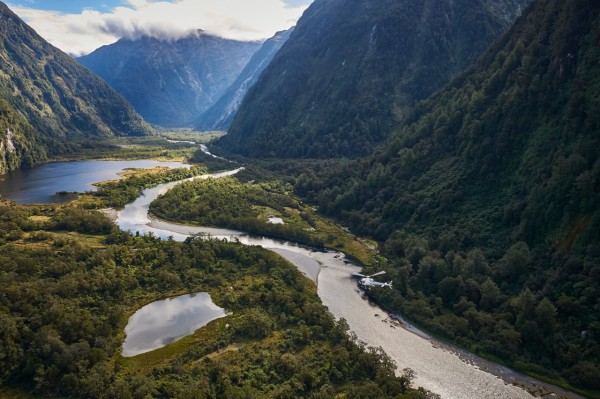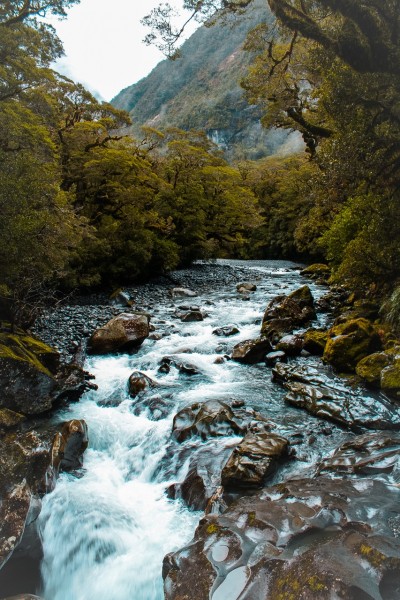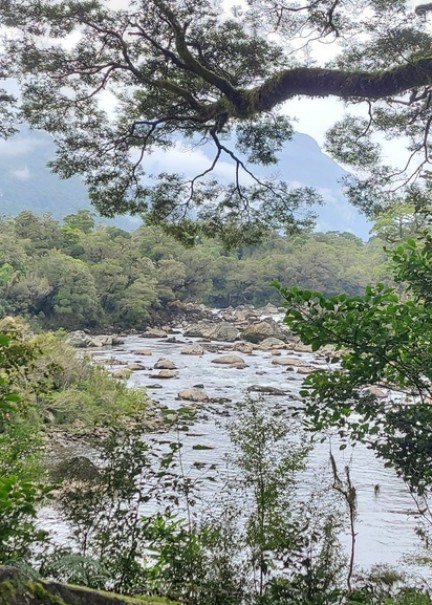Fiordland: A cherished corner of the world
Fiordland National Park is one of New Zealand’s treasured natural icons and is internationally recognised as part of the wider UNESCO World Heritage site, Te Wāhipounamu (Place of the Greenstone). It is home to glaciers, alpine ranges and unique flora and fauna that has been in existence since New Zealand was part of the supercontinent Gondwanaland.
Fiordland National Park itself covers 1.2 million hectares of mountain, lake, fiord and rainforest environments and is administered by the Department of Conservation. Human activity within Fiordland has been limited because of its challenging and wild landscapes.
Early Māori visited Fiordland for hunting, fishing and gathering takiwai (a unique form of New Zealand jade or pounamu). Much later, European sealers and whalers took shelter in the fiords and built a handful of small settlements, these being New Zealand’s earliest European settlements. But overall the sheer steepness of the terrain, the incredible isolation, and the wettest climate in New Zealand deterred all but the hardiest from settling in the region.

Fly the spectacular Joes River © Graham Dainty
A sound or a fiord?
Fiordland National Park is known around the world for its breathtaking collection of fiords which ironically are mostly named as sounds. Interestingly, both terms are correct. Fiord is a geological term for an ice-carved landscape that has been inundated by water (usually the sea), and a sound is a geographical term for a large ocean inlet. Cast your eye over a map of the South Island’s untamed western coastline and read out a roll call of names both in Maori and English - each with their own story to tell. In order to convey the sense of majesty that the landscape provides the entire area was named Fiordland.
New Zealand is one of only a few places on the planet where you can see the spectacular sight of glacial-carved fiords.
Discover the fiords:
- Piopiotahi / Milford Sound
- Patea / Doubtful Sound
- Tamatea / Dusky Sound
- Rakituma / Preservation Inlet

Water-shaped landscapes at The Chasm
WHAT’S THE WEATHER LIKE IN FIORDLAND?
If there’s one thing Fiordland is most famous for, it’s water. Here, the beauty of the area is shaped by water - lakes, rivers, streams, waterfalls, lush rainforest, stunning fiords and water locked up as glaciers. The secret to enjoying your time here is to be prepared for Fiordland weather and be prepared for rain - at any time of the year. Of course you may strike a drought - two days or more without rain! Bring layers for clothing, sensible footwear and of course, a good raincoat.
Find out what the weather is in Fiordland right now
Spring Weather
Sept-Nov: This is the equinox period and a time when Fiordland often experiences unsettled weather patterns, including more wind and rain than at other times of the year. It is also common to experience the occasional storm which may bring snow to low levels. Around Fiordland, you will see lambs, daffodils and cherry blossoms. Daylight savings starts in October, making the evenings even longer.
Summer Weather
Dec-Feb: These are the warmest months of the year where temperatures can reach up to 30 degrees Celsius (80 degrees Fahrenheit). Although wind and rain are still common, it is likely that there will be longer periods of settled weather in summer. Daylight hours are long with dawn at about 5.30 am and dusk at about 9.30 pm. In the height of summer, the hottest hours of the day are from about 3.30 pm. Join the local children and families at any of the beaches for a BBQ and an evening swim. You might even like to jump off Te Anau’s famous wharf.
Autumn Weather
March-May: Autumn continues to bring pleasant weather with. March is often warm and things generally begin to cool down towards the end of April and into May. Daylight hours start to shorten, and although the native forest remains green, the exotic trees in the townships start to change to vibrant colours. Late autumn brings the crispness of early morning frosts and mist. The senses start to come alive as temperatures begin to drop.
Winter Weather
June-Aug: Surprisingly, winter in Fiordland is the most settled time of year. Although the daylight hours are much shorter with sunrise being about 8.30 am and sunset about 4.30 pm the skies are often blue and cloudless. The air is crisp and fresh, and snow is seen on the mountains. A trip into Piopiotahi / Milford Sound is a spectacular event with snow to low levels. Bring lots of layers, including a warm hat and gloves and you will feel more alive than ever.
GETTING TO FIORDLAND
Fiordland National Park is located on the south-west corner of the South Island of New Zealand. The townships of Te Anau and Manapouri are used as a base for exploring Fiordland and offer a wide range of accommodation options as well as restaurants, shops, services and activities.
From Te Anau or Manapouri, there are many ways to get to Fiordland including, scenic flights, private charters, scenic cruises and coach and cruise options.
FAQs about Fiordland National Park
Can I stay in Fiordland National Park?
Yes. Te Anau and Manapouri are "base camp" for your Fiordland National Park visit.
What is there to do in Fiordland National Park?
Fiordland is most famous for hiking and walking. Three of New Zealand's Great Walks are found in Fiordland (Kepler, Milford and Routeburn) and there is a huge number of day walk options. Te Anau and Manapouri offer a huge range of activities to do on the lake.
Where can I see Fiordland Crested Penguins?
Patea / Doubtful Sound, Piopiotahi / Milford Sound and the other fiords of Fiordland all provide opportunity to see Fiordland Crested Penguins. The best time to see them is July - November.
How big is Fiordland?
Fiordland National Park is now over 1.2 million hectares in size, and encompasses mountain, lake, fiord and rainforest environments.
